
Previously, we’ve covered the most expensive electric vehicles on the road in 2021, and focused on consumer-grade vehicles you’re more likely to actually see on the road. Much of the feedback in the comments relayed that many of the EVs listed weren’t truly the most expensive. While we’d argue that original list pertains more to the most expensive vehicles to reach series production for consumers, we heard you. Now, you also have a list of the most expensive electric vehicles that exist on planet Earth, regardless if they’re actually available for sale. Enjoy.
Table of contents
- Breaking down the most expensive electric vehicles ever made
- Tesla Founder’s Series Roadster
- Aston Martin Rapide E
- Mercedes-Benz SLS AMG Electric Drive
- Rimac Automobili Concept_One
- NIO EP9
- Hispano Suiza Carmen Boulogne
- Lotus Evija
- Automobili Estrema Fulminea
- Rimac Automobili Nevera
- Automobili Pininfarina Battista Anniversario
- Aspark Owl
- What did we miss?
Breaking down the most expensive electric vehicles ever made
We will start at the most affordable (ha!) and work our way down the list, toward the most expensive electric vehicle on the planet.
To help narrow down the candidates to the absolute, top tier, most expensive, we will only include fully-electric vehicles. We can save those plug-in hybrid EVs for another day (sorry McLaren).
Note, these prices are (est.) MSRPs with zero add-ons or customizations unless specifically noted to garner the most expensive version. Prices also do not include any destination or other fees or state or federal tax credits.
Tesla Founder’s Series Roadster
The Tesla Roadster was the original electric vehicle to debut for the American automaker. It helped show that EVs could be carbon conscious and cool, helping pave the way for Tesla to become the most valuable automaker by market cap.
To pay homage to this trailblazing EV, Tesla is (probably) releasing a second-generation Roadster with groundbreaking specs, which may include the unconfirmed potential to hover.
According to CEO Elon Musk, the Roadster redux will reach a 620-mile range, and will zoom from 0-60 mph in 1.9 seconds. Musk even teased that these are the “base specs,” hinting at even better performance.
Tesla’s website is currently taking reservations for the new Roadster as well as a variation called the Founders Series Roadster.
It remains unclear what the extra $50k for the Founders Series will get consumers, but Tesla is only taking reservations for 1,000 total. That would make it a collector’s item and could explain the price bump.
The Founders Series Tesla Roadster costs $250,000. When it was unveiled in 2017, Musk said the Roadster would deliver in 2020… then 2021. Next, Musk announced another Roadster delay to 2022, so Tesla could focus on the Cybertruck… which has also now been delayed.
Most recently, Tesla’s Chief delivered more bad news, stating that the Roadster redux has now been delayed to 2023 with a not so optimistic outlook on meeting this new deadline. A lot will depend on the global semiconductor shortage. According to Musk:
2021 has been the year of super crazy supply chain shortages, so it wouldn’t matter if we had 17 new products, as none would ship. Assuming 2022 is not mega drama, new Roadster should ship in 2023.
Whenever it does deliver, it is sure to turn heads.

Aston Martin Rapide E
Next on our list of the most expensive electric vehicles is the Aston Martin Rapide E. This is a fully-electric version of the Rapide sports car that emerged in 2010.
The Rapide E ditched the v12 engine for twin rear motors capable of generating 950 Nm (~750 ft-lb) of torque and 612 PS (~604 hp).
It can travel 0-60 mph in under four seconds and can reach a top speed of 155 mph. This makes it a worthy getaway car for James Bond in his next battle against the planet’s biggest nemesis “Carbonfoot.”
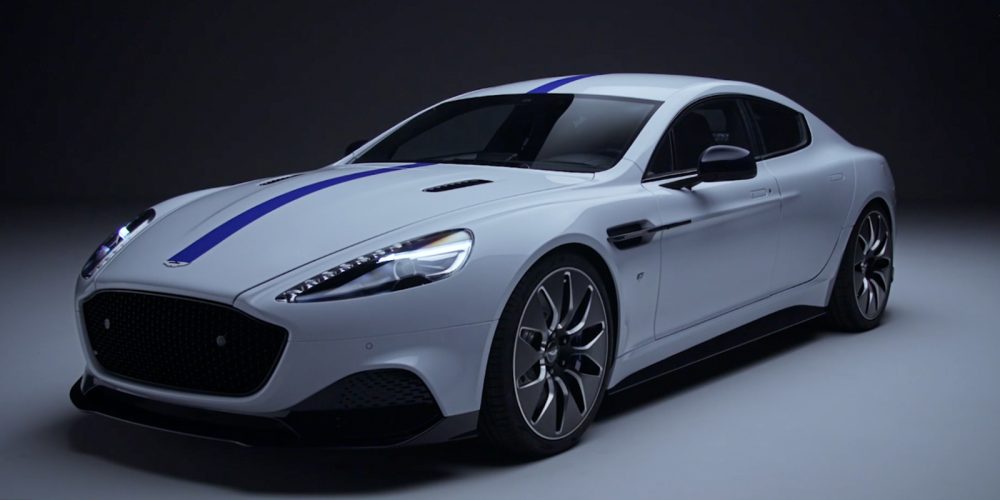
The Rapide E was introduced as a concept in 2015, then unveiled in its production form, four years later. The British automaker planned to produce 155 Rapide E vehicles as a limited run, then nixed the whole project altogether.
Aston Martin instead decided to use the Rapide E as a research project in developing future EVs, like its Lagonda electric SUV.
This EV never went on sale, but made the list because it was estimated to cost around $330,000.
The Rapide E is still out there in the world, like in Monaco where it once tore up the Formula E track:
Mercedes-Benz SLS AMG Electric Drive
Speaking of electric vehicles that are hard to come by, is the Mercedes-Benz SLS AMG Electric Drive. In addition to having an acronym filled name, the SLS AMG Electric scored impressive marks at a time when electric vehicles weren’t as prevalent.
This sports car was introduced in the summer of 2013 as a limited edition, electric version of the ICE SLS AMG. The Electric Drive Mercedes is powered by four motors that offer 740 horsepower, and 738 lb-ft of torque.
Ahead of its time, this EV allowed each motor to selectively drive all 4 wheels, helping it accelerate from 0-100 km/h (62 mph) in 3.9 seconds.
Furthermore, the Electric Drive SLS AMG housed a 400 V lithium-ion battery with 60 kWh capacity. This gave it an NEDC range of 250 km (160 mi). If you just scoffed, remember that this model was produced eight years ago.
Less than 100 SLS AMG Electric Drives were produced, making them a sure-fire collector’s car.
This model sold for around $544,000 in 2013, so it’s a safe bet that it has only gone up in value for those select few who know where one might be hiding.
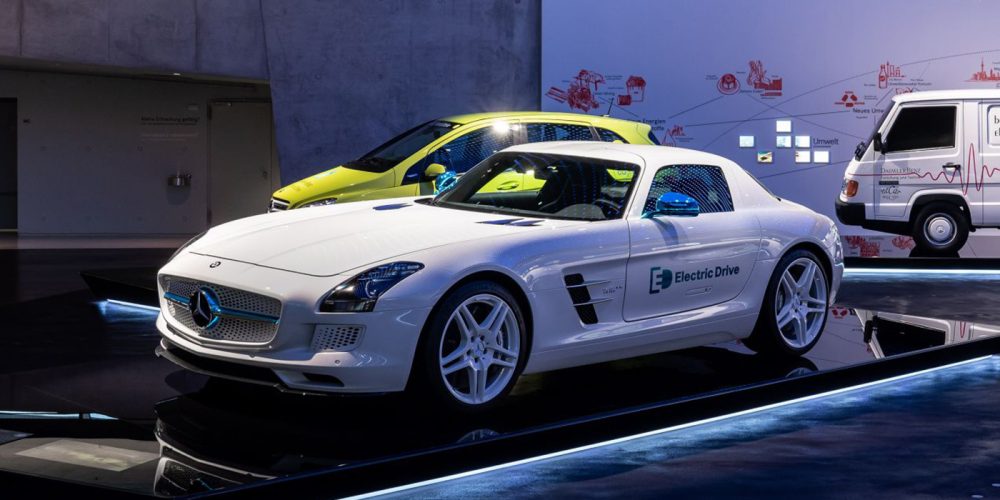
Rimac Automobili Concept_One
Rimac Automobili is a Croatian automaker that began as a hobby out of Mate Rimac’s garage. The Croatian founder blew the combustion engine in his BMW 3 series, and replaced it with an electric powertrain.
Rimac Automobili was founded in 2009, after gaining investor attention. That is where it began developing its first electric sports car, the Rimac Concept_One.
After debuting in 2011, the Concept_One finally reached production in 2013, although it was scarce.
The electric powertrain on the Concept_One offers 1,224 horsepower and 1,180 lb-ft of torque. The electric hypercar can accelerate from 0–100 km/h (62 mph) in 2.5 seconds and can reach a top speed of 340 km/h (~211 mph).
The motors are powered by a 90 kWh battery, offering a range of 349 km (217 mi) on a single charge. Similar to the Mercedes mentioned above, the C_One is powered by four separate liquid-cooled, electric motors.
They are controlled by a torque vectoring system that distributes the power to the wheels to best suit driving conditions. This also gives the driver the ability to switch the power from front-wheel to rear-wheel drive, or equally distribute the power between all wheels.
When the Concept_One was finally produced in 2013, only eight were made. Only seven now remain after someone accidentally destroyed one on television.
At the time of production, the Rimac Concept_One was for sale at about $1 million. Given that only seven remain in this world, you can imagine it costs more than that eight years later.
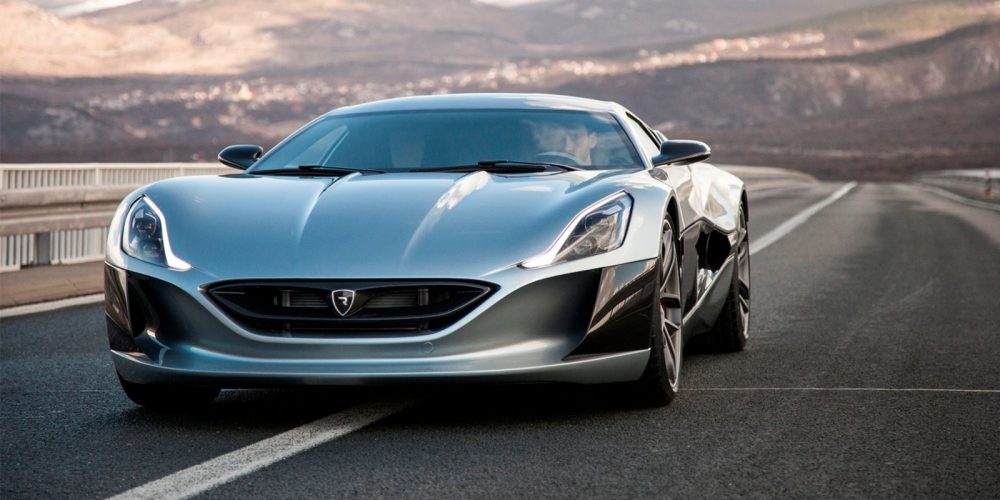
NIO EP9
The EP9 is a marvel built alongside its Chinese automaker NIO. This two-seat sports car actually debuted the same day the NIO brand was established. Developed and built in just eighteen months, the Electric Performance 9 (EP9) is one of the fastest electric vehicles on the planet with the track records to prove it.
Each wheel on the EP9 has its own liquid-cooled motor, offering 335 horsepower. That totals about 1,341 horsepower in all.
Similar to the Rimac C_One, The EP9 offers all-wheel drive and individual-wheel drive. It also includes an advanced torque vectoring system that can adjust the power output to each wheel.
What’s cool about the EP9 is its downforce of 24,019 N. According to NIO’s website, “When the downforce weighs more than an elephant (and the car), you can rely on EP9 to grip every racetrack with the same ease as if it were racing on the ceiling.”
Aside from practically driving up walls, and defying the laws of physics, the EP9 can travel around 265 miles on a single charge and recharge in 45 minutes.
The EP9 can accelerate from 0 to 100 km/h (62 mph) in 2.7 seconds and can achieve a top speed of 350 km/h (217 mph).
Unfortunately, only six EP9s were originally produced and were sold to company investors for about $1.2 million each.
NIO later announced plans to produce ten more for about $1.5 million each, bringing the global total to 16 EVs.

Hispano Suiza Carmen Boulogne
Next on our list is a boutique automaker out of Spain with nearly 120 years of history. Hispano Suiza was founded in 1904 and had a prominent track record of producing luxury cars, aircraft engines, trucks and weapons throughout the early to mid-1900s.
The brand was revived as an automotive manufacturer a decade ago, and has found its niche in ultra-luxurious, unique supercars designed and manufactured as one of a kind art pieces.
Introducing the Hispano Suiza Carmen, a 100% electric “hyperlux” vehicle introduced in 2019. Not to be outdone, Hispano Suiza introduced a sportier version in 2020 called the Carmen Boulogne, was presented in 2020.
The Boulogne will deliver 1,114 horsepower from four permanent magnet, synchronous motors housed in the rear axle and 80 kWh lithium-ion batteries, delivering 1,160 Nm of torque. It can travel from 0 to 100 km/h (0-62 mph) in less than 2.6 seconds with a range of 400 km (249 miles).
While the performance may not best many of the other EVs on this list, the design and personalizion of the Carmen is where much of its value lies. Hispano Suiza has said that no two Carmen vehicles are alike, offering 1,904 different combinations of personalization for customers.
Speaking of customers, there won’t be too many. Hispano Suiza only plans to produce 19 Carmen hypercars in total, and only five of those will be Carmen Boulognes. While the various design differentiations will lead to varying prices, the Hispano Suiza Carmen starts around $1.93 million and goes up from there.
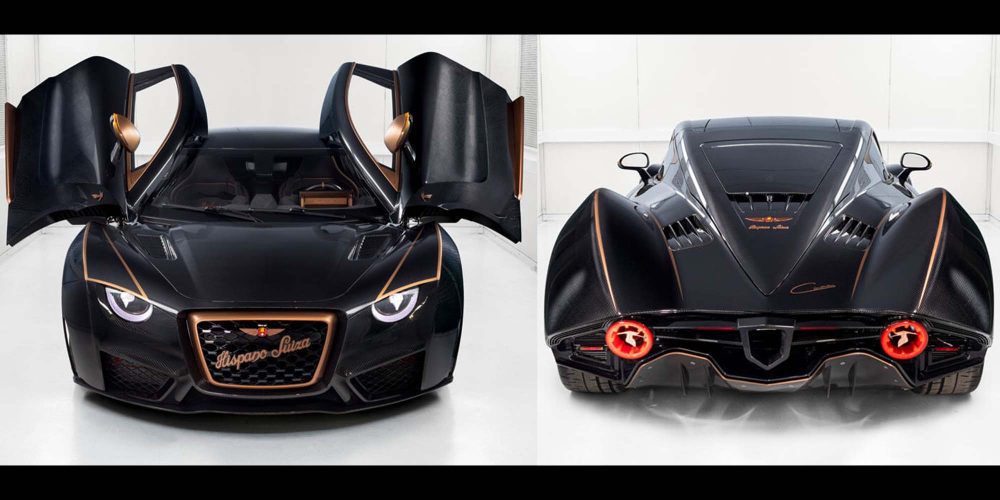
Lotus Evija
Moving onward but staying in Europe, we have the brand new Evija from Lotus. The Evija was first unveiled in 2019 as the first all-electric (and limited) offering from Lotus cars.
After its official debut, Lotus began extensive high speed testing of its Evija prototype and made (sound) waves on the track at Goodwood SpeedWeek.
While the Evija technically remains a prototype until it begins a limited production run, its target numbers on Lotus’ website are impressive.
The electric sports car is expected to deliver 2,000 PS (~1973 HP), target a max speed of 200+ mph, and reach a target range of 215 miles. Lotus claims that the Evija will also accelerate from 0 to 100 km/h (62 mph) in under 3 seconds.
At a weight of 1,680 kg (~3,704 lbs), the Evija is expected to be the lightest electric hypercar to ever enter production. This accomplishment comes from Lotus’ recent announcement of new lightweight architecture to support it upcoming family of electric hypercars, beginning with the Evija.
As previously mentioned, the Evija will see a limited release from Lotus. The British automaker has previously shared plans to delivery just 130 Evija hypercars.
According to Lotus, production was slated to begin sometime before mid-2021. However, we still have not seen any deliveries of the Evija as of September 2021.
What about price, though? You know we’re getting near the end of our list. Each of the 130 Lotus Evijas should cost around $2.1 million.
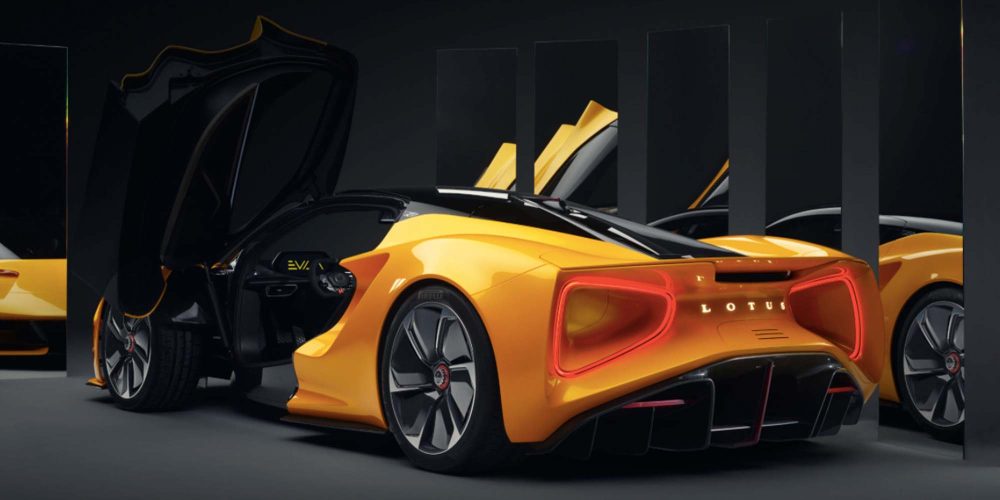
Automobili Estrema Fulminea
This automaker is by far the newest on the list, having only been founded in 2020. Automobili Estrema is an Italian electric hyper and supercar manufacturer founded by Gianfranco Pizzuto, a co-founder of the original Fisker inc. in 2007.
The name translates to “extreme” in Italian, and so far, it’s Fulminea electric hypercar fits the bill. According to its creators, Fulminea is an Italian adjective, feminine and singular, meaning “instantaneous” or, “lightning fast.”
The Fulminea was publicly unveiled in May of 2021 ahead of its limited production run scheduled for 2023. So far, Automobili Estrema has shared that the Fulminea will be the first street legal hypercar equipped with a 100 kWh Hybrid Battery Pack developed alongside specialists specialist IMECAR Elektronik.
This hybrid pack will use a combination of ABEE’s (Avesta Battery Energy Engineering) solid state cells paired with ultra-capacitors. Automobile Estrema explains:
These two different cell types are packed into 2 separated robust carbon composite cases, the one with the ultra-capacitors on the front axle while the bigger one containing the “cell to pack” solid state Li-ion cells positioned behind the cabin and before the rear axle for a perfect weight distribution and low center of gravity.
The Fulminea’s electric powertrain will utilize four motors, gathering peak power of 1.5 MW (2,040 HP), accelerating from 0 to 320 km/h (0 to 200 mph) in under 10 seconds. The expected WLTP range will be 520 km (~323 miles).
Due in part to the solid-state cells in the hybrid battery, Automobili Estrema is promising an energy density of 450 Wh/kg (1,200 Wh/l) with a predicted weight under 300 kg (661 lb).
The automaker says that as a result the total curb weight of Fulminea will 1,500 kg (3,307 lb). Move over Lotus Evija!
Automobili Estrema has already relayed that the 2023 production of the Fulminea will only deliver 61 units. Due to this exclusivity, the upcoming Fulminea is expected to cost $2.4 million per.
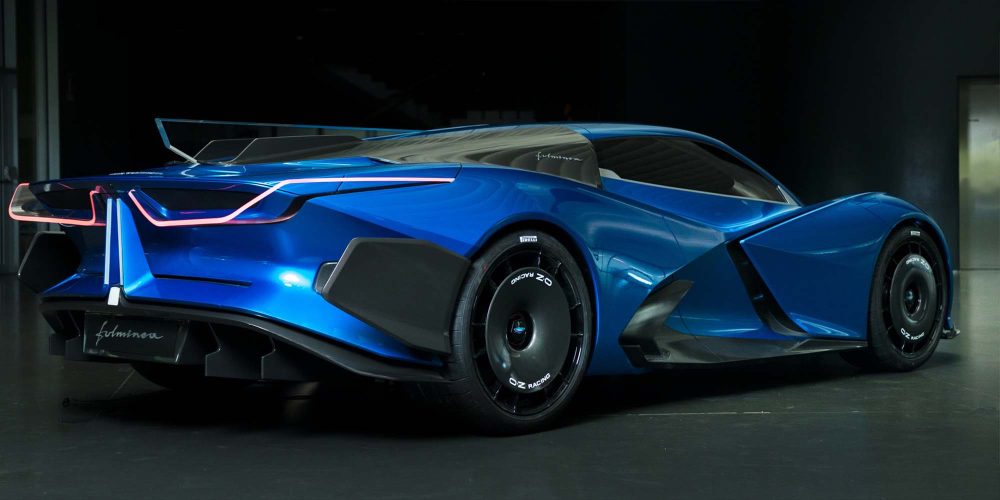
Rimac Automobili Nevera
As you can tell, we’ve fully surpassed the million-dollar mark and are in the big leagues for exotic EVs. Next on the list of most expensive electric vehicles is the C_One’s sibling, the Rimac Nevera.
Originally unveiled as the Concept_Two, Rimac eventually renamed its second EV the Nevera. Like most little brothers, the Nevera plans to one-up its predecessor as much as possible.
Rimac Automobili describes its Nevera as, “a new breed of hypercar”. The lightweight EV is comprised of mostly carbon fiber, including around two battery packs harnessing 120 kWh.
Four electric motors power each individual wheel, offering four-wheel drive plus dynamic control. It also features all-wheel torque vectoring (are we noticing a pattern yet?)
According to its vehicle page, the Nevera can load selected racetracks into its on-board systems using its “Driving Coach” function. This feature offers precise guidance on racing lines, braking/acceleration points, and steering inputs.
The interior features six different interface screens showcasing everything from telemetry graphs to your latest K-Pop playlist.
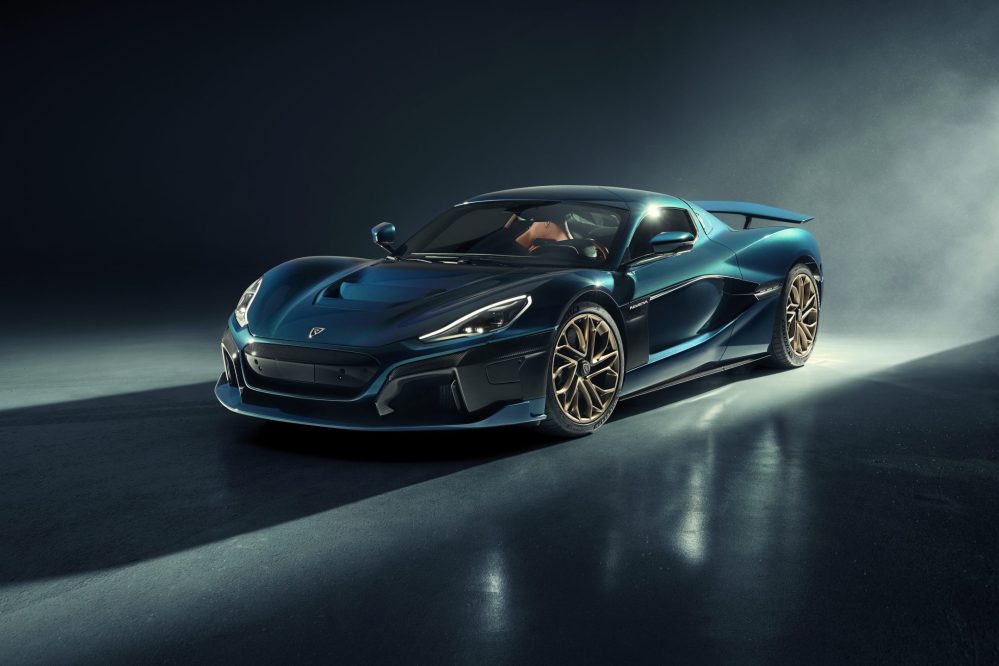
Specs on one of the world’s most expensive electric vehicles
Let’s get into the specs. According to Rimac, the C_Two will holster 1,914 horsepower (1,400 kW), jolting the hypercar to a top speed of 258 mph. The automaker is also claiming acceleration of 0-60 mph in 1.85 seconds (with a one-foot roll-out).
These stats make the Nevera one of the fastest electric vehicles in the world… with a price tag to match. Although previous reports had the Nevera at a longer range over 440 miles, Rimac’s website currently lists it at a 550 km WLTP range or 341 mi (still subject to final testing).
Rimac has already seen a maximum number of reservations for the 150 Nevera electric hypercars it plans to manufacture.
Production vehicles were supposed to complete development in 2020 but were delayed due to the COVID-19 pandemic.
When Rimac’s production does get back up to speed, we can expect to see the first delivery and final price of the Nevera hypercar.
We originally rumored this limited run Rimac to cost between $1.8 and 2 million. However, more recent pricing has surfaced, and each of the 150 reservation holders of the Rimac Nevera will be paying an estimated $2.4 million each.

Automobili Pininfarina Battista Anniversario
Say that 10 times fast. The upcoming Battista electric hypercar is the lovechild of Automobili Pininfarina GMbH in Munich, and the Pininfarina car design firm in Italy.
It will actually be the first vehicle to bear the Automobili Pininfarina branding. This electric hypercar’s name is a tribute to Pininfarina founder Battista Farina. Since its unveiling in 2019, the Pininfarina Battista has gathered a lot of hype thanks to its initial specs and design elements.
The Battista is powered by a 120 kWh battery pack that is supplied by Rimac Automobili. In fact, the Battista is partially assembled at the same facility in Croatia as the Rimac Nevera.
Its lithium/nickel/manganese/cobalt/oxide battery powers four unique motors that offer 1,900 horsepower, a top speed of 350 km/hr (~217 mph), and 2,300 Nm of torque.
Furthermore, Automobili Pininfarina claims the Battista can travel 0-60 mph in under two seconds. Its battery range tops out at 500 km (~311 mi).
Battista Anniversario
Automobili Pininfarina has recently shared plans to produce 150 Battista vehicles for deliveries around the globe. Included in those 150 will be five… yes only five, Anniversario edition Battistas.
Each Battista Anniversario will offer the same performance, but with custom paint and wheels. According to its website:
Each Battista Anniversario is hand-painted in Cambiano through one of the most complex painting processes in the world: the car needs to be disassembled and reassembled three times before it obtains its final stunning livery. The colour scheme is an homage to the Piedmont environment, where Battista “Pinin” Farina worked and lived: Bianco Setriere, Grigio Antonelliano, and of course the Pininfarina signature colour, the Iconica Blu.
This past August, Automobili Pininfarina teased the production-spec version of its Battista hypercar ahead of its official debut at Monterey Car Week. It was joined alongside the Battista Anniversario.
When full-production begins, the Battista will cost around $2.2 million. The Battista Anniversario however, is going to run you $2.9 million.
Remember, there will only be five on Earth… five!

Aspark Owl
At last! We have reached the end of the list and our pinnacle of the most expensive electric vehicles on the planet. What better vehicle to top our list than one named after a creature that looks down upon the world and its prey from above.
Behold the Owl, Aspark’s three-year project and recently confirmed fastest electric hypercar in the world.
Aspark Co. is a Japanese car manufacturing and engineering firm, founded in 2005 in Osaka. The Japanese company is not shy about how proud it is of its achievement in the Owl either.
According to its site, the Owl “has the most powerful 4 electric motors ever made.” The motors combine to produce a total power of 1,480 kW with 2,012 horsepower. The overall torque in the Owl is around 2000 Nm (1,475 ft-lb).
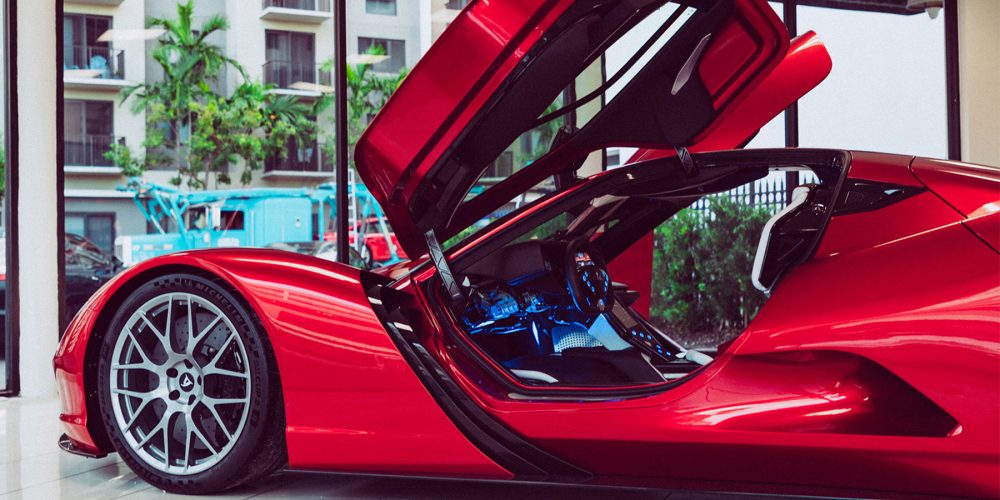
Furthermore, Aspark claims the Owl has nearly 3x more power than Formula-E cars and 2x more than Formula-1 cars. T
he automaker also believes the rotation of the motor is the fastest in the world at 15,000 rpm.
This helps the Owl’s motors to accelerate from 0-60 mph in 1.69 seconds and reach a top speed of 400 km/h (249 mph). That’s enough for the global top spot in acceleration.
Sales of the 50 planned Owl hypercars began last December, and you can still request to own one on the company’s website.
How much you ask? When Aspark first unveiled the Owl in 2019, it was anticipated to cost $3.2 million.
However, now that the production models are rolling out, the base price for the Aspark Owl is around $3.5 million (2.9 million euros). That makes it not just the fastest, but the most expensive electric vehicle on the planet.

What did we miss?
Any other stupidly expensive EVs out there? Let us know in the comments below.
Perhaps you’re not so much interested in the most expensive vehicles on the planet, but would rather research the least expensive. We’ve got you covered on that front too, check it out here.
Subscribe to Electrek on YouTube for exclusive videos and subscribe to the podcast.
Author: Scooter Doll
Source: Electrek



